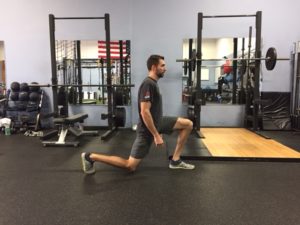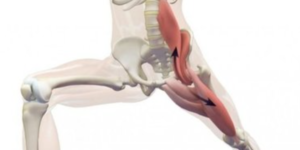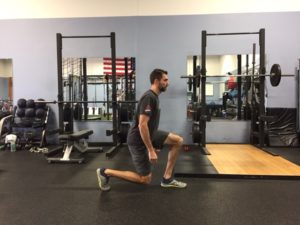There is no question about how good lunging is for your race training program. I can only think of one reason why you would not want to include it in your training. That being that it hurts to lunge.
So assuming lunging doesn’t hurt you, it is a great way to improve lowering body strength to become a better running and to help attack those hills.
While lunging is a popular exercise and done by most, there is a good chance you are making a big mistake when you lunge that could dramatically reduce you results and likely lead to injury. This common mistake is over stepping.
At a quick glance an over stepped lunge doesn’t look like anything that could lead to issues. See the picture below.

There are two big issues that will come up here. First, you are relying on your stretch vs. your strength. When you stretch a muscle out and “hang out” on that stretch, your muscles don’t have to work as hard to create the movement. You essentially using the elastic capability of the muscle tissue to bounce off of.
Sometimes we do this in training to improve explosive power, as in plyometrics. But for improve strength with a lunge, you want to use the muscle force not the stretch.
Our bodies are phenomenal at finding the easy way out. Try it out for yourself Do a few lunges with a large step so you feel that stretch in your hip. Now, try it again with a smaller step and complete full range of motion. You will notice how much more your quads and hips have to work. This is exactly what we want our of our training.
The second reason you want to avoid this, is the stress it will place on the joints. First, if you are maxing out your hip flexor muscles, like your psoas, you are pulling on your lumbar spine. This will pull you into extension (arching your back) with every step. Now do loading lunges and you are extended and compressing your spine. Not the best combo. 
Plus, you can look at the pull on the other side. When the quad is on full stretch it will pull on the quad tendon which pulls on the patella. This may lead to unneeded stress on the knee joint as well.
What to do instead.
Now you can step too small, so we have to find that sweet spot. When you step and tap your knee to the ground, make sure you knee is around 2 inches away from your front heel. This will limit the stretch put on the muscle but be a big enough step to allow for proper technique. See the pic below to get the idea.

Obviously there are different types of lunges you can do for different reasons, but it is critical you master the fundamentals first. Try this out in your routine. I promise you will notice the difference, but you will be amazed on how fast you get good at them, and how much better you will feel during your runs.
Keep training smarter!
Mike Deibler MS, CSCS, SGX
Need help with other compensations during your training? Click here to take our free self screening course.

